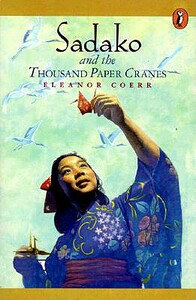Take a photo of a barcode or cover
At age two, Sadako Sasaki was a survivor of the bombing of Hiroshima. When she contracted leukemia from the radiation, she began folding origami cranes. A Japanese legend contends that if a person folds 1,000 paper cranes then their gods will grant that person one wish.
Upon reading this book, sometimes adults get wrapped up in historical debates. I've heard some people decry the American bombings, while others criticize Japan's expansionist agenda. I think this book is very open about its pacifist message.
When I have taught this book to middle schoolers, they pick up the pacifist theme right away. They also realize that the topics in this book are incredibly complex. (In more recent years, I've had students ask questions about Sadako's health insurance.) For these multiple questions, there is not a "right" answer. However, there are many, many more valid questions to ask. And asking questions is something middle schoolers excel at, so why not give them a book that they can really explore? I've never used this book for a Socratic Seminar, but I think this book combined with a few other articles could make for an incredible student-led discussion.
Upon reading this book, sometimes adults get wrapped up in historical debates. I've heard some people decry the American bombings, while others criticize Japan's expansionist agenda. I think this book is very open about its pacifist message.
When I have taught this book to middle schoolers, they pick up the pacifist theme right away. They also realize that the topics in this book are incredibly complex. (In more recent years, I've had students ask questions about Sadako's health insurance.) For these multiple questions, there is not a "right" answer. However, there are many, many more valid questions to ask. And asking questions is something middle schoolers excel at, so why not give them a book that they can really explore? I've never used this book for a Socratic Seminar, but I think this book combined with a few other articles could make for an incredible student-led discussion.
emotional
reflective
sad
medium-paced
This was a reread from my childhood. I still love it even now. The based on a true story about a little girl and her courage in the face of her radiation leukemia is really moving. The surviving history that was recounted from the surviving family members is even more heart wrenching. I'll probably always love this book.
I read this book after spending some time folding paper cranes for a thousand-crane project engineered by a friend of mine, and I really, really liked it. It's a powerful story which made me cry more than once, and I think it does a good job of portraying elements of Japanese life without being too heavy-handed or distracting the reader from the story.
HOWEVER... I was horrified to find, on reading up on the real Sadako afterwards, that Coerr totally fictionalized elements of the story, including the most dramatic parts (like the number of cranes Sadako folded). The best way I can describe it is that she Hollywoodized the story to make it pull as many heartstrings as possible - like the true story isn't sad enough already.
This is just another example of why you can't trust historical fiction or fictionalized accounts of historical events. As a history major, it really ticks me off. I'm sure that a kid reading Coerr's version would certainly get a proper sense of the tragedy of the atom bomb and of Sadako's death, but they would also get a completely inaccurate representation of what actually went on.
HOWEVER... I was horrified to find, on reading up on the real Sadako afterwards, that Coerr totally fictionalized elements of the story, including the most dramatic parts (like the number of cranes Sadako folded). The best way I can describe it is that she Hollywoodized the story to make it pull as many heartstrings as possible - like the true story isn't sad enough already.
This is just another example of why you can't trust historical fiction or fictionalized accounts of historical events. As a history major, it really ticks me off. I'm sure that a kid reading Coerr's version would certainly get a proper sense of the tragedy of the atom bomb and of Sadako's death, but they would also get a completely inaccurate representation of what actually went on.
reflective
sad
fast-paced
Plot or Character Driven:
Character
Strong character development:
Complicated
Loveable characters:
Yes
Diverse cast of characters:
No
Flaws of characters a main focus:
No
emotional
informative
inspiring
sad
fast-paced
Plot or Character Driven:
A mix
Strong character development:
No
Loveable characters:
Yes
Diverse cast of characters:
N/A
Flaws of characters a main focus:
No
Even though this was a rather short read, I enjoyed it so much. I heard about the story behind this book on YouTube and just had to read it.
It is a retelling of the story of Sadako, a girl who was born in Hiroshima in 1943 and later suffered from leukaemia. Getting hospitalised and undergoing medical care, she was given a golden paper crane by her best friend. Sadako's friend told her to fold origami paper cranes to make a wish once she would reach a thousand. Inspired by the Japanese legend, the one who creates a thousand origami cranes would be granted a wish. And all Sadako wished for was to live through this terrible disease.
In this book, Sadako only created 644 origami cranes, the rest being finished by her friends. According to her family, especially her older brother Masahiro Sasaki, Sadako finished this task and died having folded approximately 1400 paper cranes.
Even though the author of this book made a few changes, the book is nicely written. Sadako's story, the events that transpired after her death and the meaning of paper cranes makes this a heartbreaking story. But it also emphasises how much a simple act of kindness can mean.
It is a retelling of the story of Sadako, a girl who was born in Hiroshima in 1943 and later suffered from leukaemia. Getting hospitalised and undergoing medical care, she was given a golden paper crane by her best friend. Sadako's friend told her to fold origami paper cranes to make a wish once she would reach a thousand. Inspired by the Japanese legend, the one who creates a thousand origami cranes would be granted a wish. And all Sadako wished for was to live through this terrible disease.
In this book, Sadako only created 644 origami cranes, the rest being finished by her friends. According to her family, especially her older brother Masahiro Sasaki, Sadako finished this task and died having folded approximately 1400 paper cranes.
Even though the author of this book made a few changes, the book is nicely written. Sadako's story, the events that transpired after her death and the meaning of paper cranes makes this a heartbreaking story. But it also emphasises how much a simple act of kindness can mean.
I happened to read this book at precisely the time it was most able to grip me by the throat, so I won't even bother being objective about it. I just hope that the children who read it will grow up to have true compassion for all the sick and the dying, as well as an abhorrence for the use of nuclear weapons. It's a beautiful, very sad story.
In the version that I read, there were some letters included at the end from young readers of this story. One of them alluded to Pearl Harbor as a sort of justification for Hiroshima, and I wanted to grab that kid's parents by the throat. But like I said, I read this at a very particular time.
In the version that I read, there were some letters included at the end from young readers of this story. One of them alluded to Pearl Harbor as a sort of justification for Hiroshima, and I wanted to grab that kid's parents by the throat. But like I said, I read this at a very particular time.
Just finished this with my son and it was fun to re-read a past favorite of mine. It actually was one of the first books I can remember saying I read and loved! It was this book that started my love for asian culture and WW2 history. I enjoyed sharing that with my son and look forward to doing it in the future with other kids of mine.





